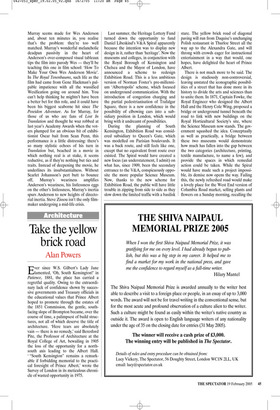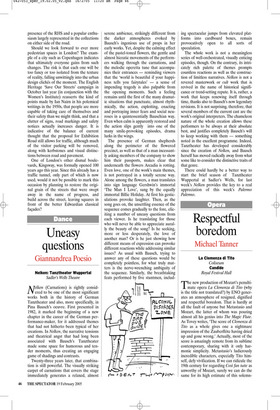Take the yellow brick road
Alan Powers
Ever since W.S. Gilbert’s Lady Jane lamented, ‘Oh, South Kensington!’ in Patience, 1881, the place has carried a regretful quality. Owing to the extraordinary lack of confidence shown by successive governments and Treasury officials in the educational values that Prince Albert hoped to promote through the estates of the 1851 Commission, the gentle, southfacing slope of Brompton became, over the course of time, a palimpsest of build structures, not all of which deserve the title of architecture. ‘Here tears are absolutely vain — there is no remedy,’ said Beresford Pite, the Professor of Architecture at the Royal College of Art, bewailing in 1905 the loss of the opportunity for a northsouth axis leading to the Albert Hall. ‘ “South Kensington” remains a remarkable if forbidding memorial to the practical foresight of Prince Albert,’ wrote the Survey of London in its meticulous chronicle of wasted opportunity in 1975. Last summer, the Heritage Lottery Fund turned down the opportunity to fund Daniel Libeskind’s V&A Spiral apparently because the intention was to display new design in it, rather than ‘heritage’. Now the museums and colleges, in conjunction with the Royal Borough of Kensington and Chelsea and the Mayor of London, have announced a scheme to redesign Exhibition Road. This is a less ambitious version of Norman Foster’s pre-millennium ‘Albertopolis’ scheme, which focused on underground communication. With the introduction of congestion charging and the partial pedestrianisation of Trafalgar Square, there is a new confidence in the possibility of elbowing cars into a subsidiary position in London, which would bring with it undreamt of possibilities.
During the planning of South Kensington, Exhibition Road was considered subsidiary to Queen’s Gate, which was modelled on Parisian boulevards. It was a back route, and still feels like one, except that no equivalent front route ever existed. The Spiral would have created a new focus (an understatement, I admit) on what has, since 1909, been the secondary entrance to the V&A, conspicuously opposite the more popular Science Museum. Now, thanks to the new scheme for Exhibition Road, the public will have little trouble in zipping from side to side as they slow down the limited traffic with a basilisk stare. The yellow brick road of diagonal paving will run from Daquise’s unchanging Polish restaurant in Thurloe Street all the way up to the Alexandra Gate, and will throng with crowds eager for instructional entertainment in a way that would, one hopes, have delighted the heart of Prince Albert.
There is not much more to be said. The design is studiously non-controversial, leaving unstated the iconographic possibilities of a street that has done more in its history to divide the arts and sciences than to unite them. In 1871, Captain Fowke, the Royal Engineer who designed the Albert Hall and the Henry Cole Wing, proposed a bridge or underground tunnel beneath the road to link with new buildings on the Royal Horticultural Society’s site, where the Science Museum now stands. The government squashed the idea. Conceptually as well as practically, a bridge between these two museums would demonstrate how much has fallen into the gap between the two categories (architecture, printing, textile manufacture, to name a few), and provide the spaces in which remedial action could be taken. While the Spiral would have made such a project impossible, its demise now opens the way. Failing this, the newly refreshed road would make a lovely place for the West End version of Columbia Road market, selling plants and flowers on a Sunday morning, recalling the presence of the RHS and a popular enthusiasm largely represented in the collections on either side of the road.
Should we look forward to ever more pedestrian spaces in London? The example of a city such as Copenhagen indicates that ultimately everyone gains from such changes. The risk is that each one will be too fancy or too isolated from the texture of reality, falling unwittingly into the urban design clichés of the moment. The English Heritage ‘Save Our Streets’ campaign in October last year (in conjunction with the Women’s Institute) reasserts the kind of points made by Ian Nairn in his polemical writings in the 1950s, that people are more capable of taking care of themselves and their safety than we might think, and that a clutter of signs, road markings and safety notices actually increases danger. It is indicative of the balance of current thought that the proposal for Exhibition Road still allows for traffic, although much of the visitor parking will be removed, along with kerbstones and visual distinctions between road and pavement.
One of London’s other dismal boulevards, Kingsway, was formally opened 100 years ago this year. Since this already has a traffic tunnel, only part of which is now used, would it not be possible to mark this occasion by planning to restore the original grain of the streets that were swept away in the name of progress, and build across the street, leaving squares in front of the better Edwardian classical façades?


















































 Previous page
Previous page